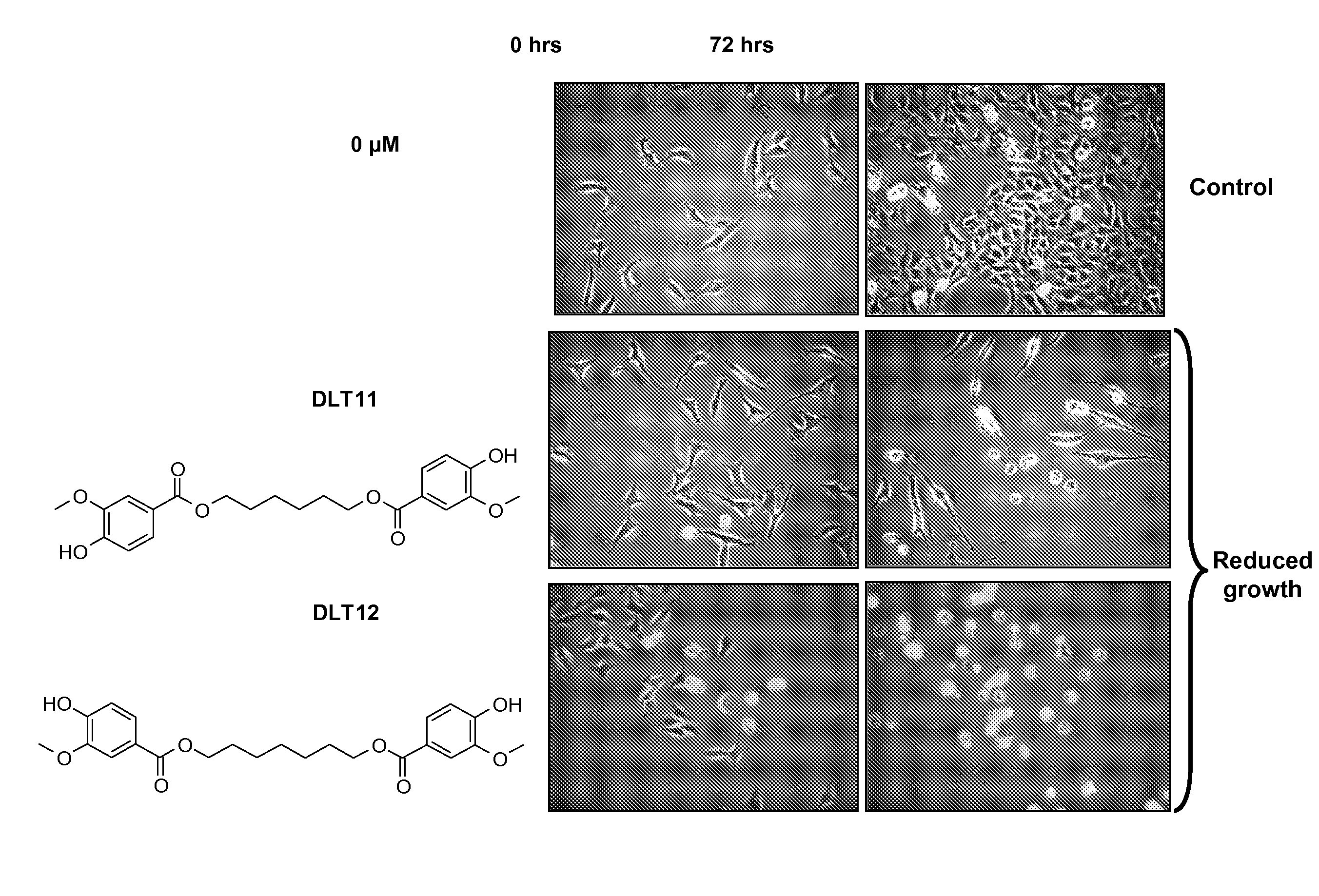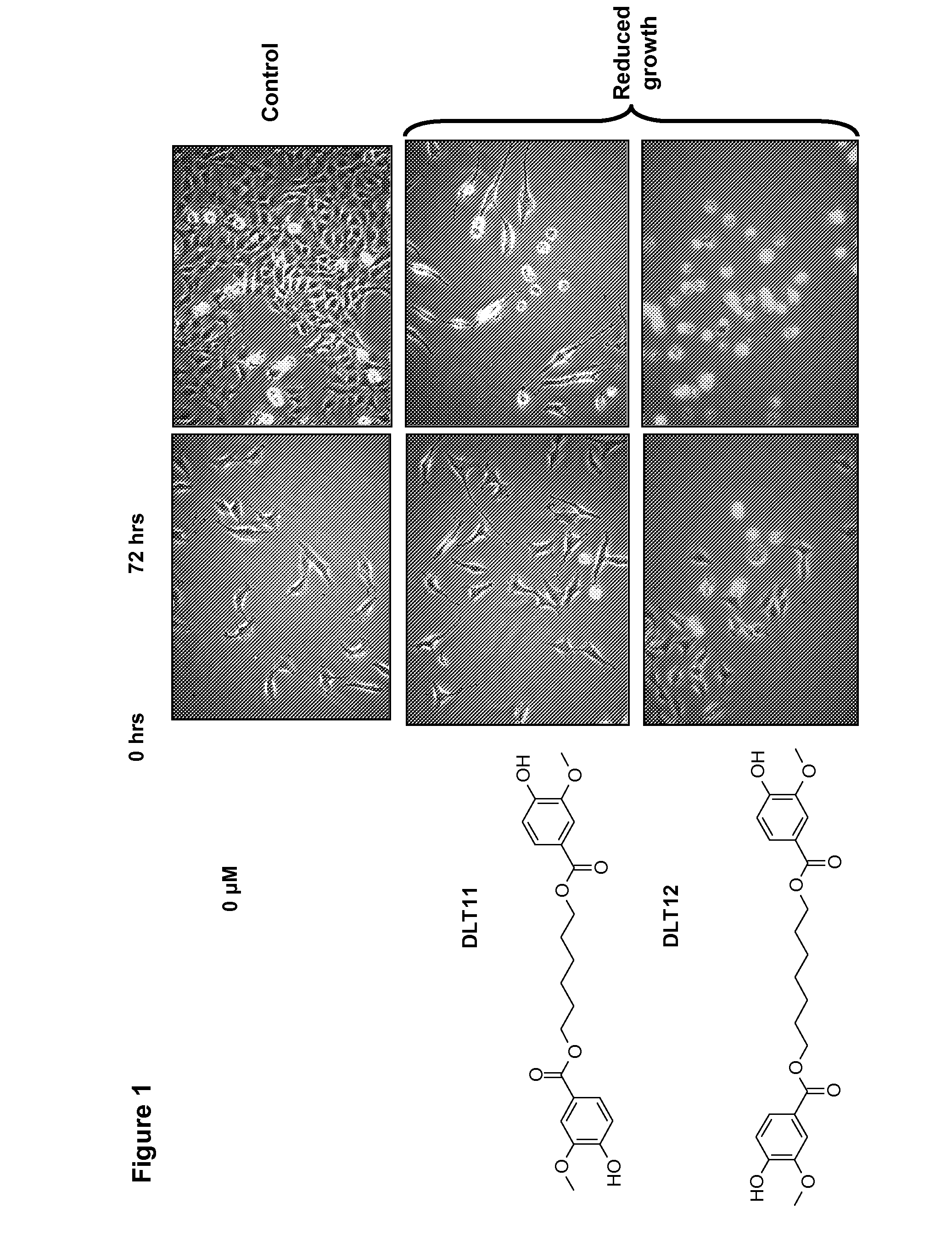Di-Vanilloyl And Tri-Vanilloyl Derivatives For Use In Anti-Cancer Therapy
a technology of divanilloyl and trivanilloyl, which is applied in the direction of biocide, drug composition, organic chemistry, etc., can solve problems such as affecting the biology of erythrocytes
- Summary
- Abstract
- Description
- Claims
- Application Information
AI Technical Summary
Benefits of technology
Problems solved by technology
Method used
Image
Examples
example 1
Synthesis of the Compounds According to the Invention
General
[0175]1H NMR (300 M), spectra were recorded on a Bruker Avance® Spectrometer. The 1H NMR chemical shifts were reported in parts par million (ppm) relative to the singlet at 7.26 ppm for chloroform in deuteriochloroform and the coupling constants are in Hz. The following abbreviations are used for spin multiplicity: s, singlet; d, doublet; t, triplet; q, quadruplet, qt, quintuplet; m, multiplet; b, broad. Routine thin layer chromatography (TLC) was performed on silica gel plates (Silicagel GF254® from VWR), column chromatography was performed on silica gel (spherical particle size 60-200 μm from MP Biomedicals). Solvents from Aldrich were used without further purification.
1. Synthesis of Intermediate I: 3-methoxy-4-[(methoxycarbonyl)oxy]benzoyl chloride
1.A. Synthesis of 3-Methoxy-4-[(methoxycarbonyl)oxy]benzoic acid
[0176]
[0177]3-Methoxy-4-[(methoxycarbonyl)oxy]benzoic acid was synthesised according to the method described by...
example 2
In Vitro Characterization of the Biological Effects of the Compounds According to the Invention
A / Effect on Overall Cell Growth
[0289]MTT tests were performed in order to rapidly, i.e. within 5 days, measure the effect of compounds of this invention on the overall cell growth. The test measured the number of metabolically active living cells that were able to transform the yellow product 3-(4,5-dimethylthiazol-2-yl)-2,5-diphenyl tetrazolium bromide (herein referred as MTT) into the blue product formazan dye by mitochondrial reduction. The amount of formazan obtained at the end of the experiment, measured by means of a spectrophotometer, is directly proportional to the number of living cells. Optical density determination thus enabled a quantitative measurement of the effect of the investigated compounds as compared to the control condition (untreated cells) and / or to other reference compounds.
[0290]Eleven human cancer cell lines and one mouse melanoma cell-line (B16F10) described in ...
example 3
Kinase Inhibition Profile of DLT11 at 20 μM
Materials and Methods
[0309]The kinase inhibition profile of DLT11 at 20 μM was determined using 250 protein kinases. Residual activity values were measured by testing each compound at one concentration in duplicate in each kinase assay. A radiometric protein kinase assay (33 PanQinase®Activity Assay) was used for measuring the kinase activity of 250 protein kinases. All kinase assays were performed in 96-well flashPlates™ from Perkin Elmer (Boston, Mass., USA) in a 50 μl reaction volume. The reaction cocktail was pipetted in 4 steps in the following order:[0310]10 μl of non-radioactive ATP solution (in H2O)[0311]25 μl of assay buffer / [γ-33P]-ATP mixture[0312]5 μl of test sample in 10% DMSO[0313]10 μl of enzyme / substrate mixture
[0314]The assay for all enzymes contained 60 mM HEPES-NaOH, pH 7.5, 3 mM MgCl2, 3 mM MnCl2, 3 μM Na-orthovanadate, 1.2 mM DTT, 50 μg / ml PEG20000, 1 μM ATP / [γ-33P]-ATP (approx. 6×1005 cpm per well), protein kinase, and...
PUM
| Property | Measurement | Unit |
|---|---|---|
| Molar density | aaaaa | aaaaa |
| Molar density | aaaaa | aaaaa |
| Molar density | aaaaa | aaaaa |
Abstract
Description
Claims
Application Information
 Login to View More
Login to View More - R&D
- Intellectual Property
- Life Sciences
- Materials
- Tech Scout
- Unparalleled Data Quality
- Higher Quality Content
- 60% Fewer Hallucinations
Browse by: Latest US Patents, China's latest patents, Technical Efficacy Thesaurus, Application Domain, Technology Topic, Popular Technical Reports.
© 2025 PatSnap. All rights reserved.Legal|Privacy policy|Modern Slavery Act Transparency Statement|Sitemap|About US| Contact US: help@patsnap.com



